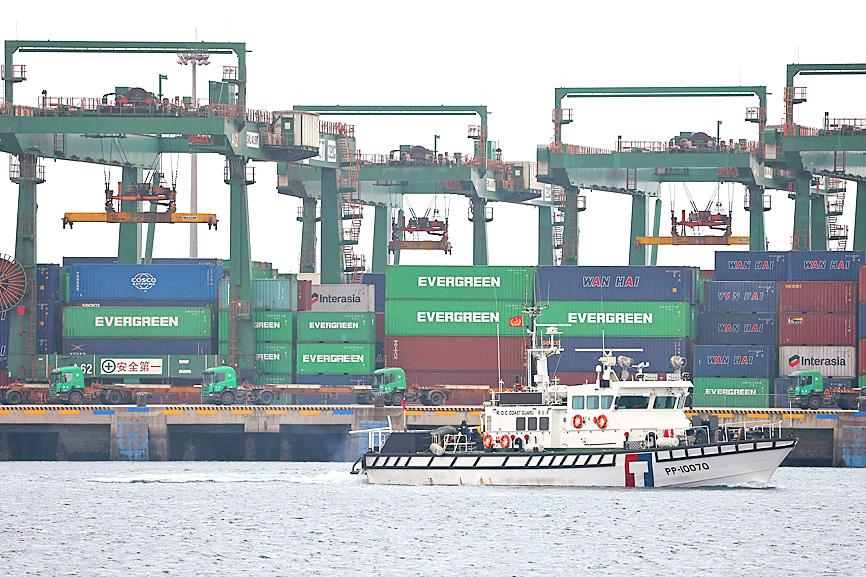Exports last month rose 9.7 percent year-on-year to US$27.79 billion, the strongest performance for February since records began, as demand for most products increased, although mineral and textile exports remained soft, the Ministry of Finance said yesterday.
The pace of the pickup is expected to accelerate this month by 15 to 20 percent to above US$30 billion after the Lunar New Year holiday disruptions of last month, the ministry said.
“The world appears poised for a recovery from the COVID-19 pandemic in light of improving trade flows,” Department of Statistics Director-General Beatrice Tsai (蔡美娜) said, adding that the outlook for the global economy would brighten further as more people get vaccinated against the coronavirus.

Photo: Ann Wang, Reuters
Technology firms have benefited from people in lockdown working and learning from home, leading to demand for flat panels, computers and smartphones, trends likely to continue after the pandemic has changed the way companies and people tackle business, shopping and other activities, Tsai said.
Shipments of electronic products increased 14.4 percent year-on-year to US$10.73 billion, with semiconductors registering a 15.3 percent increase to US$9.74 billion, the monthly report showed.
Exports of information and communication technology products advanced 7.3 percent, while exports of optical devices, mainly flat panels, soared 23.8 percent, it said.
Exports of raw materials such as chemicals, plastics and base metals posted growth rates of 2.7 to 18 percent year-on-year, the report said.
Exports of machinery equipment increased 10.7 percent, while those of transportation equipment surged 20 percent, it said.
Exports of minerals and textiles bucked the trend with declines of 44.4 percent and 6.4 percent year-on-year, as crude oil prices remained low, although they are showing signs of improvement.
Imports rose 5.7 percent to US$23.28 billion, giving the nation a trade surplus of US$4.51 billion, a 36.4 percent increase year-on-year, the report said.
Exports in the first two months of this year posted a robust 23.2 percent increase to US$62.06 billion, stronger than the 16.77 percent gain projected for this quarter by the Directorate-General of Budget, Accounting, and Statistics last month.
Major suppliers of semiconductors, ICs, notebook computers, flat panels and other critical components have said that they have more orders than they can fulfill.
Imports in the first two months of the year grew 17.7 percent to US$51.36 billion, translating to a trade surplus of US$10.7 billion, a 59 percent increase from the same period last year, ministry data showed.
Exports in the first half of this year would also benefit from a low comparison base last year when nations introduced lockdowns to rein in the pandemic, leading to diminished economic activity, the ministry said.

Taiwan Semiconductor Manufacturing Co (TSMC, 台積電) last week recorded an increase in the number of shareholders to the highest in almost eight months, despite its share price falling 3.38 percent from the previous week, Taiwan Stock Exchange data released on Saturday showed. As of Friday, TSMC had 1.88 million shareholders, the most since the week of April 25 and an increase of 31,870 from the previous week, the data showed. The number of shareholders jumped despite a drop of NT$50 (US$1.59), or 3.38 percent, in TSMC’s share price from a week earlier to NT$1,430, as investors took profits from their earlier gains

In a high-security Shenzhen laboratory, Chinese scientists have built what Washington has spent years trying to prevent: a prototype of a machine capable of producing the cutting-edge semiconductor chips that power artificial intelligence (AI), smartphones and weapons central to Western military dominance, Reuters has learned. Completed early this year and undergoing testing, the prototype fills nearly an entire factory floor. It was built by a team of former engineers from Dutch semiconductor giant ASML who reverse-engineered the company’s extreme ultraviolet lithography (EUV) machines, according to two people with knowledge of the project. EUV machines sit at the heart of a technological Cold

TAIWAN VALUE CHAIN: Foxtron is to fully own Luxgen following the transaction and it plans to launch a new electric model, the Foxtron Bria, in Taiwan next year Yulon Motor Co (裕隆汽車) yesterday said that its board of directors approved the disposal of its electric vehicle (EV) unit, Luxgen Motor Co (納智捷汽車), to Foxtron Vehicle Technologies Co (鴻華先進) for NT$787.6 million (US$24.98 million). Foxtron, a half-half joint venture between Yulon affiliate Hua-Chuang Automobile Information Technical Center Co (華創車電) and Hon Hai Precision Industry Co (鴻海精密), expects to wrap up the deal in the first quarter of next year. Foxtron would fully own Luxgen following the transaction, including five car distributing companies, outlets and all employees. The deal is subject to the approval of the Fair Trade Commission, Foxtron said. “Foxtron will be

INFLATION CONSIDERATION: The BOJ governor said that it would ‘keep making appropriate decisions’ and would adjust depending on the economy and prices The Bank of Japan (BOJ) yesterday raised its benchmark interest rate to the highest in 30 years and said more increases are in the pipeline if conditions allow, in a sign of growing conviction that it can attain the stable inflation target it has pursued for more than a decade. Bank of Japan Governor Kazuo Ueda’s policy board increased the rate by 0.2 percentage points to 0.75 percent, in a unanimous decision, the bank said in a statement. The central bank cited the rising likelihood of its economic outlook being realized. The rate change was expected by all 50 economists surveyed by Bloomberg. The